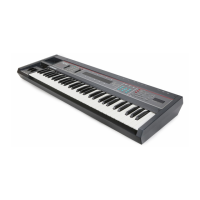SQ-80 — Musician's Manual
About Cross Wave
TM
Synthesis
The sound of most musical instruments can be separated into two basic parts:
• The Attack — the initial transient frequencies of the sound, which quickly die away. The scratch
of a bow on a violin string, the sound of a mallet striking a vibraphone, the pluck of a guitar string —
these are all examples of Transient Attacks.
• The Sustain — after the initial attack dies out, most sounds settle into a relatively stable pattern of
repeating wavecycles.
Usually the most complex and interesting part of a sound, and the hardest part to synthesize. is the initial
Attack. Ideally, we would like to be able to sample (digitally record) the Attack segments of various
sounds, and then Crossfade those Attacks with other sampled or synthesized Sustain Waves. This would
allow us to custom-build sounds with an endless variety of Attack and Sustain characteristics"
This is exactly what the SQ-80 is designed to do. Within each Program, each of the SQ-80's three
Oscillators can play a different Wave. Among the available Waves are Transient Attacks, which are
used for the initial Attack portion of the sound, and two types of Sustain Waves — Waveforms, which
are single-cycle waves repeated over and over, and Inharmonic Loops, which are dynamic. multi-cycle
waves.
You can assign one Oscillator to play a Transient Attack. and have the other two play Sustain Waves.
Or you can assign two Oscillators to play different Transient Attacks simultaneously, and use one Sustain
wave. Any Oscillator can be assigned to play any Wave. The best thing about CrossWave
TM
synthesis
is that you can use it to recreate the sound of a real instrument, such as a cello or marimba. or you can
create entirely new sounds by combining totally unrelated Attack and Sustain Waves. How about a
Bowed Bell? Or a Plucked Vocal? The possibilities are limited only by the imagination of the
programmer.
Crossfading Waves
The basic idea of Crossfading is that the volume (or amplitude) of one sound fades out over time as
another sound fades in.
• The SQ-80's Transient Attack Waves have their own built-in fade-out. That is, these Waves do not
loop — they play through once at the beginning of the sound and stop.
• The Sustain Waves (the Waveforms and Inharmonic Loops) are faded in using the SQ-80's
Envelopes. One of the four Envelopes is assigned to modulate the DCA (Digitally Controlled Amplifier)
of the Oscillator playing the Sustain Wave (see Modulators. later in this Section). By setting the
Envelope's TIME 1 to a value of around 10, we can cause that Oscillator's level to fade in as the Transient
Attack Wave played by another Oscillator is fading out. Here's the net effect:
Section 3 — Voice Programming 29

